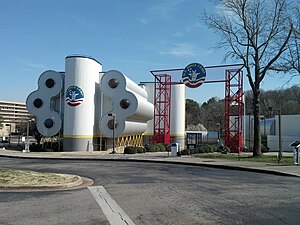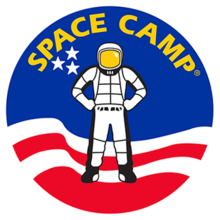This article contains promotional content. (August 2023) |
Space Camp is an educational camp in Huntsville, Alabama, on the grounds of the U.S. Space & Rocket Center (USSRC) museum near NASA's Marshall Space Flight Center.[1] It provides educational programs for children and adults on topics such as space exploration, aviation, and robotics. It is run by the Alabama Space Science Exhibit Commission.[2]
| Space Camp | |
|---|---|
 Habitat One (left) and Habitat Two (right) at Space Camp. Habitats house campers staying for multiple days. Campers enter through the red gate. | |
 | |
| Location | Huntsville, Alabama, U.S. |
| Coordinates | 34°42′41″N 86°39′15″W / 34.71139°N 86.65417°W |
| Operated by | U.S. Space & Rocket Center |
| Established | 1982 |
| Website | https://www.spacecamp.com/ |
History
editSpace Camp was founded in 1982 by USSRC Executive Director Edward O. Buckbee as an educational camp to promote mathematics and science to children using the U.S. space program as a basis. The idea for the camp was proposed by Wernher von Braun in 1977 while touring the USSRC, where he noticed a group of students taking notes on what they were learning.[3][4]
U.S. Space & Rocket Center Education Foundation
editThe U.S. Space & Rocket Center and the camp in Huntsville are operated by the Alabama Space Science Exhibit Commission, a state agency whose members are appointed by the Governor of Alabama. The U.S. Space & Rocket Center Foundation is a separate non-profit entity and its board members are not appointed by the governor. It is responsible for scholarship, fundraising, and the licensing of camps outside the United States.
Programs
editThe center offers several programs. Space Camp was the first of the camp programs offered, and is used also as the umbrella organization name.[citation needed]
- Space Camp is a "six-day" (really four-and-a-half days -- Sunday afternoon through Friday 9am) program offered for children between 9 and 11 years old. Children study space, aviation, and robotics.
- Space Academy is intended for ages 12–14 and is also offered in six-day sessions.
- Advanced Space Academy is designed for 15 to 18-year-olds. The program was originally known as Space Academy Level II and was started in the Fall of 1987.[citation needed] In 1987, the Space Academy Level II program was college accredited (1 hour) through the University of Alabama Huntsville.
- The Family Camp[5] program allows parents or guardians to attend Space Camp with their child. The program is run throughout the year, and lasts three to four days. Family Camp also has an Aviation Challenge option during summer months.
- Advanced Space Academy Elite is offered to graduates of the Advanced Space Academy program.
Additionally, Space Camp has previously offered a twelve-day Advanced Space Academy program that included features such as multiple missions, scuba diving, use of some of the Aviation Challenge facilities, and a twenty-four-hour extended duration mission.
Other programs
editOther programs include corporate programs, programs for adults and educators, educational field-trips for school groups, and the X-Camp outdoor leadership camp. There were also special alumni sessions during the summer of the 25th anniversary.[citation needed]
Occasionally themed camps have been offered, usually in conjunction with museum exhibits. During the summer of 2010, a Jedi Experience camp was offered in connection with the traveling museum exhibit Star Wars: Where Science Meets Imagination.[6]
Aviation Challenge
editThe Aviation Challenge (AC) is a set of aviation-oriented programs at the camp, consisting of three programs for children from ages 9–18. The camps utilize computer-based flight simulators, which train attendees to fly, act, and think like fighter pilots.
Facilities
editSimulators
editThere are several simulators at Space Camp, such as:
- The Multi-Axis Trainer (MAT) simulates disorientation, similar to the Multiple Axis Space Test Inertia Facility (MASTIF) developed for Project Mercury
- The 1/6 Chair simulates walking on the Moon
- The 5DF Chair simulates the frictionless environment of outer space in five degrees of freedom
- The Manned Maneuvering Unit (MMU) simulates working untethered in a frictionless environment, such as during extravehicular activity (also known as an EVA or spacewalk).
Space Camp additionally uses rides or attractions that are on site at the USSRC as instructional tools. The Space Shot simulates liftoff, and the G-Force Accelerator simulates the G-forces put on astronauts while re-entering the Earth's atmosphere or during launch.
The Intuitive Planetarium provides a venue for presenting space and science-oriented shows produced through a Digistar 7 system and 5 Christie laser projectors.[7] The planetarium is part of the center's museum complex.[8] In February 2019, the Intuitive Planetarium replaced the Spacedome IMAX theater, which had operated at the Center since 1982.[7]
Accommodation
editIf a Space Camp program extends beyond a single day, participants are accommodated at either Habitat 1 or Habitat 2. These habitats are facilities that house both the trainers and trainees. These are mainly used by the Space Academy campers.
Aviation Challenge trainees stay in Habitat 3 where they are required to maintain military standards to their bays and racks.
Both habitats are segregated between male and female campers, usually being the males on the first floor and the females being on the second.
Other camps
editThere are a number of internationally licensed Space Camps, including Space Camp Turkey, Space Camp Canada (French: Camp Spatial), and Space Camp Belgium. There have been other space camps in the United States in the past, but they have been closed.
Space Camp Florida
editSpace Camp Florida was established in 1988 and shared facilities with the Astronaut Hall of Fame in Titusville, Florida, both of which were operated by the now-defunct U.S. Space Camp Foundation. The Space Camp facility in Florida closed in 2002 due to low attendance, which led to financial difficulties. About 50,000 students attended the camp during its run, but in its final year, as few as 14 participants filled 276 slots.[9] The Astronaut Hall of Fame was sold to the Delaware North corporation and remained open until 2015 as an added attraction to the Kennedy Space Center Visitor Complex, with several simulators previously used by the camp available to all visitors.[10] As of 2020[update], the building was being used by Lockheed Martin to support work on the NASA Orion crew capsule.[11]
Space Camp California
editSpace Camp California was operated by the now-defunct U.S. Space Camp Foundation at Mountain View, California from 1996 to 2002, when it closed due to financial difficulties.[12]
Space Camp Hall of Fame
editThe Space Camp Hall of Fame was inaugurated in 2007 during the 25th-anniversary celebrations. The Hall was established to honor alumni and former employees by recognizing their contributions and personal time spent at the Space Camp.[13]
| Inductee | Year |
|---|---|
| Wernher von Braun | 2007 |
| Edward O. Buckbee | 2007 |
| Georg von Tiesenhausen | 2007 |
| Dan Oates | 2007 |
| Dorothy Metcalf-Lindenburger | 2007 |
| James Rice | 2007 |
| Amanda Stubblefield | 2007 |
| Penny J. Pettigrew | 2007 |
| Oscar Holderer[14] | 2008 |
| Marlenn Maicki[14] | 2008 |
| Lisa Devries[14] | 2008 |
| Vincent Vazzo[14] | 2008 |
| Phillip A. Smith[14] | 2008 |
| Josh Whitfield[14] | 2008 |
| Jim Allan[15] | 2009 |
| Jerry Gleason[15] | 2009 |
| Robert Pearlman[15] | 2009 |
| Francis French | 2010 |
| J. David Hnyda | 2010 |
| Danny R. Jaques | 2010 |
| Andrea M. Hanson | 2010 |
| Michelle Thaller | 2011 |
| Valerie Meyers | 2011 |
| William Burke Hare III | 2011 |
| Stephanie Abrams | 2012 |
| Lara Elizabeth Warren | 2012 |
| Ed Van Cise | 2012 |
| Robert L. Gibson | 2012 |
| Kaya Tuncer | 2014 |
| Samantha Cristoforetti | 2014 |
| Michelle Lucas | 2014 |
| Susanna Phillips | 2015 |
| Elizabeth Keller Bierman | 2015 |
| Kathleen Rubins | 2015 |
| Bobak Ferdowsi | 2015 |
| Jason Hopkins | 2016 |
| Amy Kaminski | 2016 |
| George T. Whitesides | 2016 |
| SpaceCamp (1986 film) | 2016 |
| Serena Auñón | 2017 |
| Michelle Christensen | 2017 |
| John Hecker | 2017 |
| Jennifer Heldmann | 2017 |
| Tara Ruttley | 2018 |
| Erika Wagner | 2018 |
| Sarah Noble | 2018 |
| Tara Sweeney | 2018 |
| Mary Funk | 2019 |
| Casey Harris | 2019 |
| Christina Koch | 2019 |
| Beth Moses | 2019 |
See also
editReferences
edit- ^ "Space Camp". www.spacecamp.com. Retrieved 2015-11-16.
- ^ "U.S. Space & Rocket Center | U.S. Space & Rocket Center". www.rocketcenter.com. Retrieved 2023-11-20.
- ^ Bob Ward and John Glenn (2009). Dr. Space: The Life of Wernher von Braun. Naval Institute Press. p. 151. ISBN 978-1591149279.
- ^ "Space Camp Hall of Fame". U.S. Space & Rocket Center. Retrieved 2023-11-20.
- ^ "Family Programs". Space Camp. Retrieved 2017-09-16.
- ^ "Star Wars: Where Science Meets Imagination (Press Materials)". 28 May 2010. Retrieved 23 November 2010.
- ^ a b Lyons, Wes (2019-02-27). "Intuitive Planetarium at U.S. Space & Rocket Center Opens Thursday". Sprocketeers. Retrieved 2021-08-13.
- ^ "Intuitive Planetarium". U.S. Space & Rocket Center. 2019-01-14. Retrieved 2021-08-13.
- ^ Sellers, Laurin (14 September 2002). "Titusville, Fla., Space Camp's Mission Is to Remain Open". Orlando Sentinel.
- ^ "Space Camp Will Keep Simulators, New Owner Says". Miami Herald. November 10, 2002.
- ^ Kelly, Emre (2020-07-17). "Lockheed Martin will lease former Astronaut Hall of Fame for NASA's Orion spacecraft". Florida Today. Retrieved 2020-09-15.
- ^ Kwan, Joshua L. (8 January 2002). "Space Camp California Closes for Lack of Funds". San Jose Mercury News.
- ^ "About the Hall of Fame | Space Camp Hall of Fame". Retrieved 2024-05-12.
- ^ a b c d e f "Hall of Fame Inductees". al.com. July 20, 2008. Archived from the original on August 4, 2008. Retrieved March 29, 2013.
- ^ a b c Clines, Keith (12 July 2009). "Space Camp adds 3 to its hall of fame". Huntsville Times. Archived from the original on 9 June 2011. Retrieved 6 September 2010.
External links
edit- Official website
- Space Camp for Interested Visually Impaired Students (SCI-VIS) Archived 2010-01-25 at the Wayback Machine
- Youth U.S. Space Camp for Hong Kong students to U.S. Space and Rocket Center in August each year
